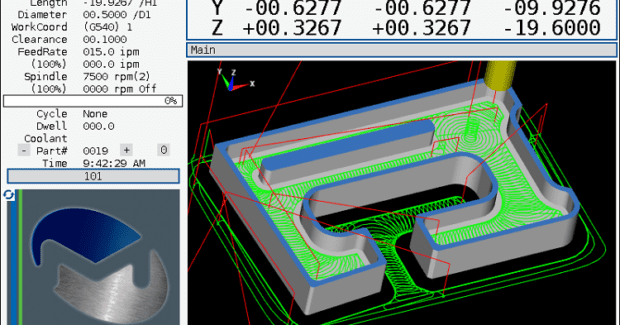Program Conversationally, But Cut Like a Boss
ChipBoss CAM software from Milltronics lets conversational program users take advantage of the latest trochoidal machining strategies to reduce cycle times up as 50 percent with 3X to 5X better tool life.
Posted: March 18, 2019
ChipBoss™ software from Milltronics USA, Inc. (Waconia, MN) uses proprietary algorithms to calculate toolpaths and control maximum allowable cutter engagement so that the whole length of a tool can be used rather than just the tip, cutting profiles at full depth rather than taking multiple depth passes. This new optional software works by automatically controlling the tool’s chip load, keeping it constant and creating the optimal chip for faster cycle times, better tool life and more accurate parts. Cycle times (depending on geometry) can be reduced by as much as 50 percent with up to 3X to 5X better tool life. Part accuracy is also improved through reduction in tool deflection. The toolpaths generated are often quite different than what conversational users might be used to . . . at first glance they might appear inefficient or even erratic. Often the tool path does not even remotely resemble the final shape that is ultimately cut. Additionally, feed rates can be much higher than what conversational program machine users are used to. The whole idea is to use tool paths that assure a constant chip load, which typically means smaller step-overs and bigger depths of cut.
The goal here is to use the whole length of the tool when pocketing or profiling. With conventional conversational programs, the usual machining strategy is to cut the profile using multiple incremental depths and only using the end or tip of the tool. ChipBoss uses much more of the flute, allowing the load, heat and wear to be spread out evenly over a much larger area of the tool and resulting in much longer tool life. It not only maximizes the metal removal and prolongs tool life, but it is but also is much easier on the machine tool because it reduces the number of times a machine needs to accelerate and decelerate. Another important feature of this conversational software is “Rest Machining.” Often when machining a part, an operator may use a large diameter cutter to remove as much material as possible, dependent on part geometry and features. But typically, some material is left behind because the large cutter won’t fit into an area without cutting material that needs to remain. This leftover material (the “rest”) would then have to be machined with a smaller cutter, wasting time as the whole part gets re-cut just to get to the smaller areas. The Rest Machining function calculates the areas to be machined and uses the smaller cutter to get just those areas, saving even more time.
A Bi-Directional turning cycle lets conversational program users effectively halve the time it takes to turn parts as it eliminates the need to cut in one direction, rapid back to the start position and then take another pass. The Bi-Directional cycle allows for “zig-zag” (or bi-directional) turning for significantly shorter cycle times. Milltronics also offers a Digital Setup Assistant (DSA) that uses Wi-Fi to make a cell phone or tablet an extension of the user’s control. This optional software feature allows an operator to reduce setup time by easily accessing photos of parts and workholding, set-up data, tooling info and more.
Milltronics USA, Inc., 1400 Mill Lane, Waconia, MN 55387, 952-442-1410, info@milltronics.com, www.milltronics.com.




